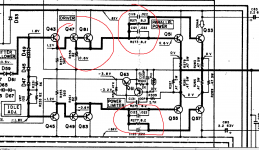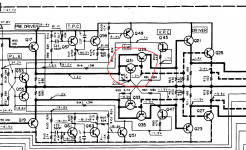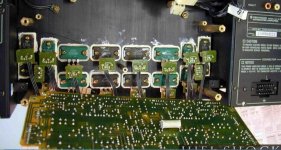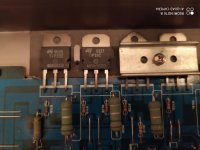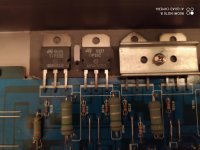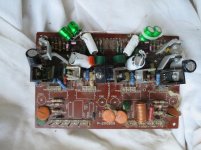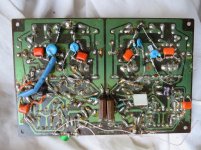Hi ! if i understand well speaking of bjts more powerful ones have a bigger SOA than less powerful ones. Is this confirmed ?
I wonder which kind of issues i can encounter if i replace let's say a NPN 80W bjt with a NPN 200W bjt.
I know already that higher gain bandwidth product can lead to instability
and this is my main concern
If i have to replace a 3 MHz part can a 10 MHz part be a safe option ?
The goal would be to have a more robust output stage (i.e. increase not the power but the soa)
Anyone who has done something similar ? is this a silly idea ?
If there is a more appropriate section please redirect my question there
Thanks a lot and kind regards, gino
I wonder which kind of issues i can encounter if i replace let's say a NPN 80W bjt with a NPN 200W bjt.
I know already that higher gain bandwidth product can lead to instability
and this is my main concern
If i have to replace a 3 MHz part can a 10 MHz part be a safe option ?
The goal would be to have a more robust output stage (i.e. increase not the power but the soa)
Anyone who has done something similar ? is this a silly idea ?
If there is a more appropriate section please redirect my question there
Thanks a lot and kind regards, gino
Last edited:
a transition from 3mhz to10mhz transistor won't be really noticeable...but one to 60 or 80mhz is...Here you have some very extreme case where you have paralleled 200mhz drivers for 80 mhz final transistors...not much compensation is used throughout all the amp but every single stage is optimized for speed.Usually higher FT transistors can oscillate, their Cbe is very low so a small base series resistor is advisable.
Attachments
Last edited:
Hi ! thank you very much indeed. This solves my doubts.a transition from 3mhz to10mhz transistor won;t be really noticeable...
My goal is to replace parts without possible having to mess with the rest of the circuit ... not always a schematic is available.
But i have an amp already repaired ... and they have used in the same output stage tip33c and tip35c that are different in power

So my idea is to use tip35c and their complementary all over the output stages ( i am also tempted to use just one pair and i know already that you like the idea of a single output pair ... i will not be stressing the amp because i will be using very few watt from it
Is it also true, as i understand, that more powerful devices increase the SOA of the output stage ?
I have very clear in my mind that cheap products are designed with a very limited budget for parts. So the whole idea is to replace parts in key positions with better speced ones in order to gain something ... like for instance reliability or less noise, less distortion and so on.
Often in cheap amps i see wires or copper traces very thin also for the high current paths ... like from output devices to speaker terminals or the ones carrying the supply voltage. It seems that Ohm's law is neglected sometimes.
I like thick wires and even copper bars for high current paths. Better flexible wires anyway ... much more convenient than bars.
Thanks a lot again.
Last edited:
Here you have an even more extreme case with (RF like)common base stage driving 80mhz transistors...but there's a catch here.People would say: Sacrilege! Too long wires to such fast transistors...those wires are just making small capacitors parallel to the active junctions making the circuit a bit slower and more stable. The common base stage(DLD) have no problem driving even higher capacitance...The DLD stage itself is wired that way...many people who saw that picture were in complete disbelief...saying that that amp is complete heresy but it works and there's no known case of an l-02 that got burned or self oscillating although it has 150v/us slew rate...Sansui and Kenwood were high speed circuit champions for sure.
Attachments
Last edited:
Welll...if your transistors are going to burn they will likely heat the pcb around them so from a later fixing perspective it's better to burn the pcb traces than the transistors and the PCB around them...
For about 20...25 years there was almost no commercial design with fast output transistors as their production seemed to cease for a while.I've seen for a few years that NAIM got back to those 50..60 mhz final transistors and they certainly made some good amplifiers with them.Digikey has them in stock from time to time too.
For about 20...25 years there was almost no commercial design with fast output transistors as their production seemed to cease for a while.I've seen for a few years that NAIM got back to those 50..60 mhz final transistors and they certainly made some good amplifiers with them.Digikey has them in stock from time to time too.
Thanks a lot again. I wonder what kind of improvement a higher gain bandwidth product device could provide for audio purposes at least. 
And above all if this improvement is audible
Are they really popular in power amps ?
As i understand with at higher values stability becomes an issue and the last thing i really want is an unstable amp. I alread burnt my fingers on the hot heatsink of an unstable amp
And above all if this improvement is audible
Are they really popular in power amps ?
As i understand with at higher values stability becomes an issue and the last thing i really want is an unstable amp. I alread burnt my fingers on the hot heatsink of an unstable amp
High speed is not for the faint hearted ones. ...
yes
From what i understand the front end is more important for sound than the final end ...
Hi ! if i understand well speaking of bjts more powerful ones have a bigger SOA than less powerful ones. Is this confirmed ?
You cannot say this as always true. There are many very high power BJTs that do not have a big SOA, especially those that are mainly used for switching.
You need to check. What you can say is that BJTs for say >200V generally have a good SOA for up to 60 or 80V.
But if your amp has been working well for you, why change the parts and risk a bonfire??
Jan
Thanks a lot again. So it is not only a problem to increase MHz but also to decrease it ?
Maybe the compensation networks you mention should be adjusted for the different devices ?
probably a schematic would help but i really do not know where to look for
I would like to play with this little amp ... but time is scarce.
By the way ... i see that the Realistic STA2250 is an interesting unit indeed.
Maybe the compensation networks you mention should be adjusted for the different devices ?
probably a schematic would help but i really do not know where to look for
I would like to play with this little amp ... but time is scarce.
By the way ... i see that the Realistic STA2250 is an interesting unit indeed.
"By the way ... i see that the Realistic STA2250 is an interesting unit indeed."
Yes...it is and it is also extremely stable .The Tuner in it is actually the better one. I also have the SCT-33 cass deck( Hitachi D-e65-rebranding).The Realistic sounds good, but not as good as a Kenwood while running class AB.I modified it to class A as its power transformer allowed me that and it was a whole lot better,but i had to revert back to class AB as i needed a complete new case for the 4 times bigger heatsink.
Yes...it is and it is also extremely stable .The Tuner in it is actually the better one. I also have the SCT-33 cass deck( Hitachi D-e65-rebranding).The Realistic sounds good, but not as good as a Kenwood while running class AB.I modified it to class A as its power transformer allowed me that and it was a whole lot better,but i had to revert back to class AB as i needed a complete new case for the 4 times bigger heatsink.
Last edited:
high speed amps will always sound better ...

You cannot say this as always true....
Jan
Thanks a lot. I am thinking to work on it because it has been already repaired and i see they have used different NPN types
I will take complete pics in the weekend of the output stages and i am open to suggestions about what to do
A good idea could be to use for instance TIP35C/TIP36C pairs ? i have to look better
Or maybe just one pair of powerful devices even if this will compromise a little the performance on lower Z loads ?
But i will take pics and upload them here for sure
Attachments
Last edited:
... the Realistic STA2250 ... I modified it to class A as its power transformer allowed me that and it was a whole lot better ...
Very interesting. When you say modified you mean that you have increased the bias ? personally i am not so hot on class A. For sure it is more demanding in terms of heat management
I see a base resistor in your picture and that makesme think that the original transistors might be higher FT as well...try 2sc5200/2sa1943...very cheap .What i don't really likein your circuit are the 0.15 ohm emitter resistors.Replace them with 0.47ohm/5w .You won't loose much power, you couldincrease the bias alittle bit anyway , but you can go with a lot more different transistors with no problem.
Yes, i replaced all the components with much better and faster transistors and some better capacitors in that final stage after that severe burn ..also used a very high quality potentiometer for bias from scraped HP analysers.That happened 9 years ago.Didn't modify any passive component value though...still have that board as i wanted to make a new pcb .The pcb has develloped an unpleasant smell after several decades of "burn in"Very interesting. When you say modified you mean that you have increased the bias ? personally i am not so hot on class A. For sure it is more demanding in terms of heat management... but what kind of improvement have you got ? i am very curious
The sound was a clear class A sound...much more melodious ...no crossover distortion probably.I only used my ears for checking.
Attachments
Last edited:
I see a base resistor in your picture and that makesme think that the original transistors might be higher FT as well ...
Thanks for your very kind help in a project that matters me a lot indeed
I promise a load of pics in the weekend ... after that if you need any particular one just tell me
I understand that this amp should be at least decent in its original form
But i subscribe to the party that everything can be improved
you mean just one pair instead of two ?...try 2sc5200/2sa1943... very cheap...
doneWhat i don't really like in your circuit are the 0.15 ohm emitter resistors. Replace them with 0.47ohm/5w. You won't loose much power, , but you can go with a lot more different transistors with no problem ...

i do not see any trimmer ... but i will look better... you could increase the bias a little bit anyway ...
- Status
- This old topic is closed. If you want to reopen this topic, contact a moderator using the "Report Post" button.
- Home
- General Interest
- Everything Else
- Possible issues in replacing bjts with more powerful parts
